Eventually, we started seeing real mountains rising above the sandy valleys.
 A lot of the landscape was very stark, almost lunar, but became beautiful as the sunlight played on it and reflected different colors.
A lot of the landscape was very stark, almost lunar, but became beautiful as the sunlight played on it and reflected different colors. The first selected village was Idaoudene, where the chief, picture here on my right, was at least 6 foot 8 inches.
The first selected village was Idaoudene, where the chief, picture here on my right, was at least 6 foot 8 inches.
 Our military escort sat down and started making the traditional Nigerien tea - they were not fasting. Nigeriens often carry around these little wire stands for charcoal, and tiny teapots, so they can sit down anywhere and make tea. The Nigerien tea ceremony is very complex and exact, and consists of three "(shot) glasses, the first "as bitter as death", the second "as mild as life", and the third "as sweet as life" (and boy, do they pour in the sugar!!) I really enjoyed their hospitality, as they always offered me a glass.
Our military escort sat down and started making the traditional Nigerien tea - they were not fasting. Nigeriens often carry around these little wire stands for charcoal, and tiny teapots, so they can sit down anywhere and make tea. The Nigerien tea ceremony is very complex and exact, and consists of three "(shot) glasses, the first "as bitter as death", the second "as mild as life", and the third "as sweet as life" (and boy, do they pour in the sugar!!) I really enjoyed their hospitality, as they always offered me a glass.



 Saley, one of our surveyors and one of my favorite people, with some of the women in Abarakan. Poor Saley had a simmering malaria practically the whole time, for which she was sporadically taking chloroquine (difficult on your stomach when you're fasting). She finally gave up and took artesunate near the end, and felt much better.
Saley, one of our surveyors and one of my favorite people, with some of the women in Abarakan. Poor Saley had a simmering malaria practically the whole time, for which she was sporadically taking chloroquine (difficult on your stomach when you're fasting). She finally gave up and took artesunate near the end, and felt much better.
 A lot of the landscape was very stark, almost lunar, but became beautiful as the sunlight played on it and reflected different colors.
A lot of the landscape was very stark, almost lunar, but became beautiful as the sunlight played on it and reflected different colors. The first selected village was Idaoudene, where the chief, picture here on my right, was at least 6 foot 8 inches.
The first selected village was Idaoudene, where the chief, picture here on my right, was at least 6 foot 8 inches. Our military escort sat down and started making the traditional Nigerien tea - they were not fasting. Nigeriens often carry around these little wire stands for charcoal, and tiny teapots, so they can sit down anywhere and make tea. The Nigerien tea ceremony is very complex and exact, and consists of three "(shot) glasses, the first "as bitter as death", the second "as mild as life", and the third "as sweet as life" (and boy, do they pour in the sugar!!) I really enjoyed their hospitality, as they always offered me a glass.
Our military escort sat down and started making the traditional Nigerien tea - they were not fasting. Nigeriens often carry around these little wire stands for charcoal, and tiny teapots, so they can sit down anywhere and make tea. The Nigerien tea ceremony is very complex and exact, and consists of three "(shot) glasses, the first "as bitter as death", the second "as mild as life", and the third "as sweet as life" (and boy, do they pour in the sugar!!) I really enjoyed their hospitality, as they always offered me a glass.
We couldn't do Abarakan, the next village, that night, so we camped out at their health center and did it the next morning before continuing on to Timia.

Sunrise over the boulders rising behind the health center. It was Sunday morning, and I climbed up to have some prayer time, which sparked an interesting conversation when the gals asked what I had been doing up there.

This is the health center, and all our vehicles, looking down from the boulders - rather pretty with the light behind it.
 Saley, one of our surveyors and one of my favorite people, with some of the women in Abarakan. Poor Saley had a simmering malaria practically the whole time, for which she was sporadically taking chloroquine (difficult on your stomach when you're fasting). She finally gave up and took artesunate near the end, and felt much better.
Saley, one of our surveyors and one of my favorite people, with some of the women in Abarakan. Poor Saley had a simmering malaria practically the whole time, for which she was sporadically taking chloroquine (difficult on your stomach when you're fasting). She finally gave up and took artesunate near the end, and felt much better.
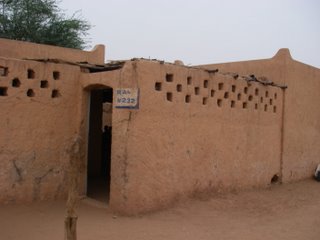 Arlit's climate is noticeably different than Agadez, as Arlit is in the true Sahara. It was about 105 in the shade and I pulled my thermometer out of the sun after it hit 115. It was a dry heat, and even 95 degrees at night felt pleasant with the desert breeze. After we finished mapping the quarters in Arlit that has been selected, we set out for the villages that had been selected in the Air mountains. You have to get across about 60 km of desert first, which is not trackless, but has many intersecting tire treads, and unless you bring a good guide to set you on the right one to enter one of the narrow passes into the mountains, you could end up in Algeria.
Arlit's climate is noticeably different than Agadez, as Arlit is in the true Sahara. It was about 105 in the shade and I pulled my thermometer out of the sun after it hit 115. It was a dry heat, and even 95 degrees at night felt pleasant with the desert breeze. After we finished mapping the quarters in Arlit that has been selected, we set out for the villages that had been selected in the Air mountains. You have to get across about 60 km of desert first, which is not trackless, but has many intersecting tire treads, and unless you bring a good guide to set you on the right one to enter one of the narrow passes into the mountains, you could end up in Algeria.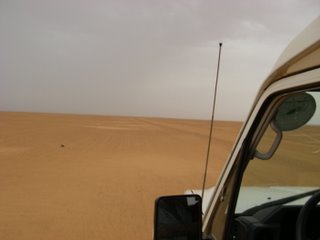 The sand and fine gravel are occasionally punctuated by large boulders and few sparse, stunted trees. When it rains it the desert, water puddles stand all around for a few days.
The sand and fine gravel are occasionally punctuated by large boulders and few sparse, stunted trees. When it rains it the desert, water puddles stand all around for a few days.
 Since there had been sporadic banditry in the mountains, we picked up an armed escort from a military base in Arlit. They were Tuareg, and I really enjoyed interacting with them.
Since there had been sporadic banditry in the mountains, we picked up an armed escort from a military base in Arlit. They were Tuareg, and I really enjoyed interacting with them. One rode in our vehicle in front, and three piled into the back of the logistician's (Idrissa's) truck. With their fatigues, turbans, and rifles, they looked like some sort of desrt militia, but you feel so safe when you know they're your guys. I love this picture of Idrissa with the thumbs up out the window!
One rode in our vehicle in front, and three piled into the back of the logistician's (Idrissa's) truck. With their fatigues, turbans, and rifles, they looked like some sort of desrt militia, but you feel so safe when you know they're your guys. I love this picture of Idrissa with the thumbs up out the window! Eventually, the desert gives way to rocks, which give way to boulders, and you start climbing into the mountains. We stopped for a photo op here.
Eventually, the desert gives way to rocks, which give way to boulders, and you start climbing into the mountains. We stopped for a photo op here.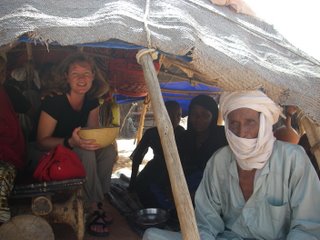
 Finally, pictoral proof that I was on a camel. Wore pants this time! :) Still made a horrible noise.
Finally, pictoral proof that I was on a camel. Wore pants this time! :) Still made a horrible noise.


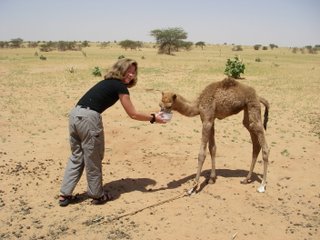
 Here's a shot of me in front of a camel, with a bunch of gorgeous kiddoes. I learned, although I don't have pictoral proof, that you can't ride a camel side saddle. I was in a skirt and couldn't get my leg over the other side of the saddle. Camels do not get up or down evenly. When they sit down, first the front legs fold half way, then the back legs fold all the way, and the front legs fold all the way, tilting crazily, and they are usually making the most horrendous half roaring half moaning sound. Quite a process!
Here's a shot of me in front of a camel, with a bunch of gorgeous kiddoes. I learned, although I don't have pictoral proof, that you can't ride a camel side saddle. I was in a skirt and couldn't get my leg over the other side of the saddle. Camels do not get up or down evenly. When they sit down, first the front legs fold half way, then the back legs fold all the way, and the front legs fold all the way, tilting crazily, and they are usually making the most horrendous half roaring half moaning sound. Quite a process! The children in Fagochia were spectacularly beautiful. While the others were mapping, they took me to the chief's wife's tent, where somehow about 20+kids crowded in around me in a tent not more than 12 feet across.
The children in Fagochia were spectacularly beautiful. While the others were mapping, they took me to the chief's wife's tent, where somehow about 20+kids crowded in around me in a tent not more than 12 feet across. I used the opportunity to take pictures and passed the camera around so they could see their pictures. I also learned my first Tamashek (Tuareg language) word - tanimert - which means thank you.
I used the opportunity to take pictures and passed the camera around so they could see their pictures. I also learned my first Tamashek (Tuareg language) word - tanimert - which means thank you. I passed my camera to one of the Tuareg women and showed her how to take a picture. Got a couple decent shots, too! The necklace I'm wearing is Tuareg made - bought in Agadez.
I passed my camera to one of the Tuareg women and showed her how to take a picture. Got a couple decent shots, too! The necklace I'm wearing is Tuareg made - bought in Agadez. There were mosquito nets hung in many of the tents. I love this shot of the kids playing underneath the mosquito net!
There were mosquito nets hung in many of the tents. I love this shot of the kids playing underneath the mosquito net!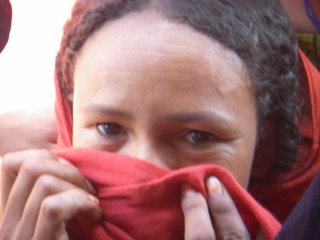 One of my favorite pictures - I'm not sure why this woman was covering the lower portion of her face as the others were not, but her eyes tell a thousand stories.
One of my favorite pictures - I'm not sure why this woman was covering the lower portion of her face as the others were not, but her eyes tell a thousand stories. One of our surveyors administering the questionaire in the tent, with the guys looking on.
One of our surveyors administering the questionaire in the tent, with the guys looking on. With the chief's wife - she is wearing one of the ornately embroidered outfits in the Agadez market picture, as well as the real indigo head scarf. Guess I needed my head covered, too. I thought she looked so elegant.
With the chief's wife - she is wearing one of the ornately embroidered outfits in the Agadez market picture, as well as the real indigo head scarf. Guess I needed my head covered, too. I thought she looked so elegant.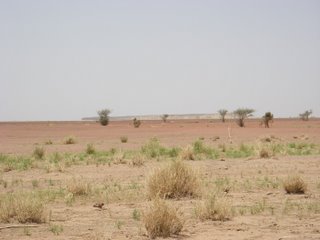
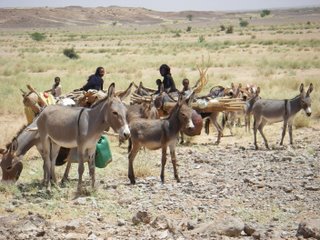
 They went that a'way!
They went that a'way!
 One of our team members buying food in the market. There are huge basins of all sorts of herbs, spices, grains, vegetables, and fruits grown in nearby oases.
One of our team members buying food in the market. There are huge basins of all sorts of herbs, spices, grains, vegetables, and fruits grown in nearby oases.

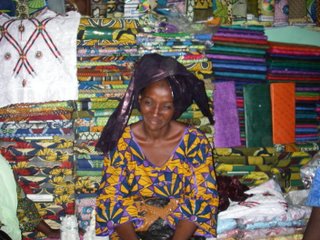 Stopping for a coke and a yogurt with the team
Stopping for a coke and a yogurt with the team Donkeys still don't get out of carrying grass, though I'm not sure where they found that much grass near Agadez!
Donkeys still don't get out of carrying grass, though I'm not sure where they found that much grass near Agadez!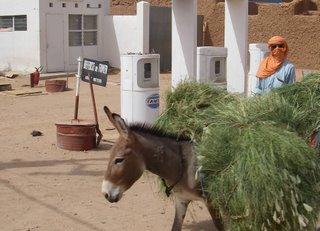
 In the end, this didn't really matter. In the domain of TMI, Niger it's a place where it's possible to drink 2 liters of water in the morning and still not pee until 10 pm that night. I probably spent most of my time pretty dehydrated, but it was more convenient.
In the end, this didn't really matter. In the domain of TMI, Niger it's a place where it's possible to drink 2 liters of water in the morning and still not pee until 10 pm that night. I probably spent most of my time pretty dehydrated, but it was more convenient.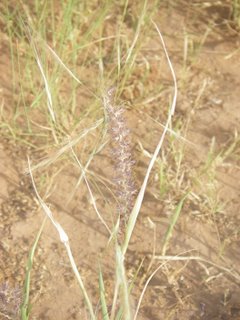 When you did get out to walk around, the little grass was often covered with these incredibly painful, tenacious little burrs that you then had to spend the next half hour removing.
When you did get out to walk around, the little grass was often covered with these incredibly painful, tenacious little burrs that you then had to spend the next half hour removing.

 Sunset - so many were just gorgeous. And during Ramadan, much looked forward to. Ramadan started in the middle of the survey, and made already grueling work (house to house mapping all day in the sun) much harder. Our teams got up at 5 am to eat and drink, and then didn't eat or drink until sunset. Some of the especially religious ones, don't even swallow their own saliva, something that was particularly annoying in our driver. Every 5 minutes, the vehicle would slow down, he'd roll down the window, and spit. Anyway, everyone knew exactly what time sunset was every night, and we'd stop right then so they could have a drink (we'd often spend the previous hour procuring ice and drinks) and a snack, and then prayer. Dinner was much later. In most Muslim countries, more food is bought and consumed during Ramadan than during other months!
Sunset - so many were just gorgeous. And during Ramadan, much looked forward to. Ramadan started in the middle of the survey, and made already grueling work (house to house mapping all day in the sun) much harder. Our teams got up at 5 am to eat and drink, and then didn't eat or drink until sunset. Some of the especially religious ones, don't even swallow their own saliva, something that was particularly annoying in our driver. Every 5 minutes, the vehicle would slow down, he'd roll down the window, and spit. Anyway, everyone knew exactly what time sunset was every night, and we'd stop right then so they could have a drink (we'd often spend the previous hour procuring ice and drinks) and a snack, and then prayer. Dinner was much later. In most Muslim countries, more food is bought and consumed during Ramadan than during other months! Here is Moussa breaking his fast with dates. Moussa Malam Barke was easily my favorite supervisor - absolutely brilliant, very hard working, very upbeat, and total problem solver. He was just terrific and I enjoyed working with him.
Here is Moussa breaking his fast with dates. Moussa Malam Barke was easily my favorite supervisor - absolutely brilliant, very hard working, very upbeat, and total problem solver. He was just terrific and I enjoyed working with him.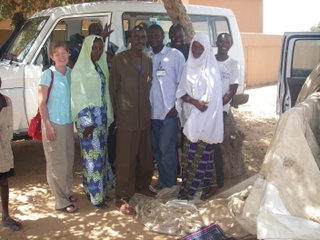 A woman in the village preparing millet - removing it from the stalks with her bare hands in the hot sun. After that, she will separate the grains from the chaff, and then pound it. Talk about a woman's work being never done!
A woman in the village preparing millet - removing it from the stalks with her bare hands in the hot sun. After that, she will separate the grains from the chaff, and then pound it. Talk about a woman's work being never done!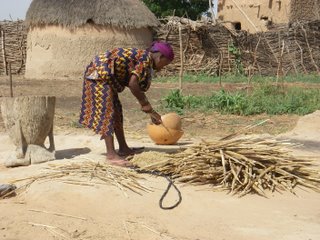

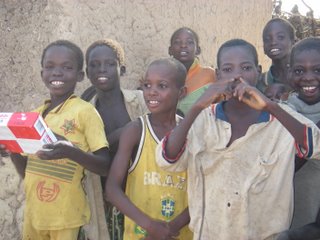 I thought this little girl was just gorgeous - took me a while to get her picture.
I thought this little girl was just gorgeous - took me a while to get her picture.





